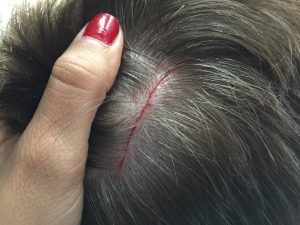BYU ElevenNEWS reporter Madison Coburn captures video of a Cooper’s hawk as it attacks her at about 7 p.m. Monday, May 24.
Attack’s from a Cooper’s hawk protecting its nest on campus will likely continue until the hatchlings have fledged.
Students and faculty have been hit in the back of the head by a Cooper’s hawk near the Brimhall and Maeser buildings on campus.
Paul Boekweg, the pest control supervisor at BYU, said Whitney Hanks, the building supervisor for the Brimhall, first noticed the hawks building their nest in the elm tree near the Brimhall a few weeks ago.

Boekweg put up a sign beneath the tree where the hawk’s nest is located to warn students. The sign reads, “Caution: You are entering Cooper’s Hawk nesting area!”
“Very little can be done about the situation,” Boekweg said. “These hawks are nesting and the Department of Wildlife Resources in Utah told us that we can’t move their nest. We can only warn students that they are aggressive.”
Boekweg explained the hatchlings would be endangered if the nest was removed.
“The pair would follow the nest, but it would put the hatchlings in danger,” he said.
Boekweg described how the Cooper’s hawks attacked each of the victims. The hawks will usually swoop from behind, slap the back of the victims’ heads with their wings and then fly off.
Brittny Lange, a BYU student majoring in education, was attacked by one of the hawks last week when she was leaving the Joseph Smith Building.

“I was walking towards the Smith Fieldhouse, down that ramp, when I felt something knock my head. I turned around and no one was there,” Lange said. “When I turned around, I saw a hawk and he tried to dive at me again.”
Once the hawk left, Lange noticed her head was bleeding. Despite that, Lange said she is still laughing about the whole experience.
Halee Rogers, an exercise and wellness student at BYU, experienced a hawk attack nearly three weeks ago while walking to church.
“It had my heart pounding and I wasn’t sure what it was,” she said.
Ken Plowman, associate professor of communication at BYU, was also a victim to the nesting hawks. “It felt like a whiffle bat hit the crown of my head,” Plowman said.

BYU students Kjersten Johnson and Scott James were both attacked last Tuesday. Johnson felt a whack behind her head, while James suffered a large scratch on his head.
Joe Hawkins, a gardener at BYU grounds, said the hawk’s behavior is not uncommon.
“In Lund, I’ll be working on the ranch and the hawks will sneak up from behind. If I am working, they’ll watch me, but if I stand still long enough, they will swoop down and hit my head,” Hawkins said about his experience on his ranch in rural Utah.
If the hawks continue to attack students the same way Lange and James were attacked, the landowners can apply for a permit to have the hawks removed, according to the U.S. Fish and Wildlife Service.
Although Boekweg would consider removing the hawks if they scratch more people, he said it is highly unlikely he would remove them. “If the attacks were really bad, we would reconsider,” he said. “But we will avoid that as much as possible since the hatchlings are very sensitive.”
Hawkins said these hawks are beneficial for controlling the pigeon population at BYU, since Cooper’s hawks prey on smaller birds.
Scott Root, the conservation outreach manager for the Department of Wildlife Resources, said the nests should not be relocated.
Root said once the baby hawks have fledged, the nesting hawks become less aggressive.




